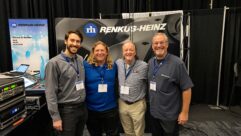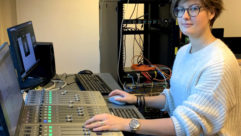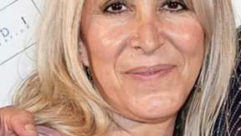
A Single Answer To Multiple AV Needs
The Ferrell Center at Baylor University breaks out of the ?one system fits all? paradigm for multipurpose arena spaces.
CHALLENGE: Develop a sound system to provide dynamic reinforcement for sporting events, yet also be reconfigured quickly and efficiently to meet the needs of other events at the venue.“It was frustrating to be soliciting designs from systems providers who kept telling us that it couldn’t be done, because we happened to believe that it could, and were not hearing rational explanations otherwise,” says Pittman.
A view of the Paul J. Meyer arena at Baylor University’s Ferrell Center, where the new line arrays provide coverage from above center court. The sound reinforcement systemcan be reconfigured for many different occasions and needs.
SOLUTION: Defy conventional wisdom by partnering with an open-minded, creative design source, capable of maximizing premium loudspeaker and digital technology and meeting budget and exceeds expectations.
INNOVATION CAN BE a solitary experience, but recently it found a welcome partner with the design and installation of a versatile, new sound reinforcement system serving the Paul J. Meyer Arena at the Ferrell Center at Baylor University, Waco, Texas.
Opened in 1988, the 10,000-plus-capacity arena is the home of Baylor’s Big 12 Conference basketball and volleyball teams, and the host of a full schedule of conventions, concerts, graduations and convocations. The brick-and-concrete building bears a round, gold-plated dome 320 feet across and 110 feet above the playing surface at its apex. It has 42 rows of seats, several of which can be retracted when needed.
Last year brought the end of the original sound system, which featured a horn/driver center cluster approach, as well as a secondary portable system that was close to 15 years old. With funds allocated for a new system, the Ferrell Center operations staff, headed by Operations Manager Drew Pittman, began in-depth research that culminated in a new system that went online just in time for the start of the 2006-07 basketball season.
From the outset, Pittman and his team envisioned an extension of the previous dual-purpose approach, albeit one where a single, full-range system could be adapted for multiple uses. Because the university is part of one of the premiere collegiate athletic conferences in the United States, the Ferrell Center officials wanted capabilities commensurate with facilities at other schools.
The research led to an evaluation of system approaches and sound and performance quality at several Big 12 arenas, as well as demonstrations of numerous leading audio components within the Ferrell Center environs. Meanwhile, Pittman also asked for system proposals from several experienced design/consulting firms.
Despite all of this homework, the process still went wanting.
“What we envisioned — and weren’t prepared to back away from without very good reason —was a true, full-range system, likely based on line arrays and that presented dynamic, concert-quality audio for all sporting events,” says Pittman. The system also had to be easily reconfigured to serve any event hosted in the arena.
Here the Ferrell Center’s new line arrays are flown and in place in an “end arena” configuration for a university convocation.
“Most of the proposals called for distributed loudspeaker approaches, which is fine and certainly proven, but that’s not at all what we had in mind,” says Pittman. “Look, it’s also our responsibility to be good stewards of the university’s money, and the amount allocated by the university was commensurate. But the various proposals were adding at least double that amount in terms of new infrastructure, and again, they weren’t meeting our goals of a truly dynamic, multi-use approach.”
Greg Parke, former technical director at the Ferrell Center, began discussing the system design goals with Tim Cain, head of Dallas-based Gemini Sound, which put the project on the right track. Cain and his colleague Jason Litt, CTS-D, an AV consultant with the Dallas office of RTKL Associates, agreed to provide a demonstration system headed by EAW KF761 line-array cabinets in an “end hang” configuration to serve a banquet held in the arena. Things quickly heated up from there, with the discussion turning to fulfillment of a complete system to meet the university’s criteria.
“This project presented new territory for us, but as we looked at the facility, and as Drew explained his vision, we could see that it would work,” says Cain. “Full-range line arrays from a central location easily could cover every seat, except for a few rows shadowed by video-screen/scoreboard structures. So then it just became largely a question of how the line arrays could be repurposed and repositioned quickly and easily, and from there, how components such as power amplifiers and processors also could be configured for dual purposes. Jason contributed several smart ideas, and we were off and running.”
Pittman wanted KF761 line-array modules to be central to the design, coming away from the demo quite satisfied with their sonic performance and coverage capabilities, as well as their rigging system. “KF761 performance is right up there with the other top models, no question,” he says. “And the rigging system on these boxes left all of the other schemes we reviewed in the dust. It’s so easy to get these arrays up in the air — first time out, 20 boxes were flown within 30 minutes, and that’s the real key. The arrays must go up and come down conveniently and really fast, because turnaround times between events can be short, and it can also impact our staff labor budget.”
FOUR PEOPLE + ONE AUDIO SYSTEM = MYRIAD SETUPS
In less than an hour, four staff members can transform the audio system at the Baylor University’s Ferrell Center from a “center-hang” configuration, used for all sporting events, to a variety of “end-hang” configurations suiting the needs of a wide range of applications. Here’s how it’s done:
Step 1 – Two staff members lower (via motorized hoists) the center truss with four line arrays to awaiting carts positioned on the floor. The bottom three cabinets in each array are detached and rolled out of the way, followed by the top four cabinets in each array being detached onto their own carts. The center truss goes up, and all array carts are rolled to the end-hang region. Duration: 14 minutes
Step 2 – Simultaneously, two more staff members work in the equipment room to disconnect all cabling for the amplifier and processing racks. Duration: 11 minutes
Step 3 – One staff member goes up to the end-hang flying grid and sets all points for chain hoists in the desired configuration, while another stages the arrays for efficient flying. Duration: 23 minutes
Step 4 – Simultaneously, the amplifier and processing racks roll out to their position behind the end- hang stage, cabled and linked to the portable power distribution system. Duration: 17 minutes
Step 5 – The line-array cabinets on carts are attached to the end-hang hoists, dual-line arrays of up to 10 modules each can be re-assembled and flown, and when needed, these can be accompanied by side-fill arrays of up to six modules each. Cabinets are repinned to establish desired splay and wrap angles. Audio cabling connects, and the arrays are hoisted to selected height. Duration: About 18 minutes
Step 6 – System DSP is accessed to the desired processing optimized preset, matching the specific array configuration. Duration: 1 minute
Total elapsed time: 56 minutes
The end-hang system can be supplemented with the SB1000 subwoofers as well as four more JFX260 loudspeakers for front fill, and eight EAW SM15 compact stage monitor wedges. Note that reconfiguring the arena for a given an application takes longer, so the technical staff is never rushed to make the audio system transition.
EAW KF760 Series line arrays feature a simple rigging system that lets a crew of two people fly arena-sized arrays in minutes. A captured hinge on top of the lower enclosure slides freely in the steel tube on the bottom of the upper enclosure. Then, load-rated, aircraft-grade aluminum quick-release pins fit through holes to lock the hinge in the tube. Specific splay angles for the KF761 are 0, 4, 8 and 12 degrees, with splay angle set at the rear of the enclosures rather than the front, leaving the fronts of all enclosures tight-packed.
Cain started the loudspeaker design process with some basic geometry, evaluating the arena’s circular shape and coming up with a configuration of arrays flown above center court, which would guarantee near-total horizontal coverage. The exceptionally wide horizontal coverage pattern of the KF761, specified as 100 degrees, played well into this approach, with four arrays (offering a total of 400 degrees of horizontal coverage) each assigned to approximately one-quarter of the coverage area.
Delivering solid vertical coverage was a relatively simple matter of determining the correct number of modules per array, along with their respective splay and down-fire angles. Attaining sufficient sound pressure levels for the entire venue proved no problem, given the high output generated by the arrays.
All of these factors, combined with the relatively uniform arrangement of the arena, led to use of four arrays each comprised of seven KF761 modules, two covering the side seating zones and the other two handling the end seating zones. All four arrays are flown from a single truss custom-built to Cain’s specifications by Xtreme Structures & Fabrication of Emory, Texas. Measuring approximately 12 feet by 12 feet, the truss can be lowered and raised with a 7,500-pound-rated hoist motor attached to the building’s grid structure. Each array has a pull-back bar, attached to a hand-crank, to adjust downward tilt.
“We’ve been flying line arrays for concerts in arenas for years, so this wasn’t a huge challenge, just a matter of matching the coverage to the space,” says Cain. “The basic mantra was getting the flying height right and the array structures right, and then making sure that output stayed controlled. There’s maybe a three-second reverberation time when the place is empty, but that dissipates a great deal when it’s full of people. So as long as we keep energy off of flat surfaces to eliminate slap-back, intelligibility remains very high.”
Two scoreboard/video screen structures in the direct coverage field lead to a slightly lower array trim height than desired, so single EAW AX364 full-range loudspeakers fly from an outer catwalk grid to bolster coverage to four small “seams” in upper seating zones. Meanwhile, four EAW JFX260 compact full-range loudspeakers enhance coverage to seats directly behind these structures. Eight EAW SB1000 dual-18-loaded subwoofers on the floor supply additional, low-end energy to enhance pre-game and halftime shows with added punch. These can move easily to accompany the system in other configurations.
To reconfigure the system, the center truss is lowered to floor where the arrays are detached in groups of four, placed on wheeled carts, and transported to one end of the arena that’s equipped with its own load-rated truss and hoist motors. To optimize each array structure and location, the staff uses EAW KF760 Wizard configuration software, as well as the EAW Smaart tuning and analysis platform in optimization. (For more on the system transition process, see sidebar.)
The power amplification and digital processing portion of the project demonstrates a good fit between recent technology developments and sharp thinking. Litt suggested Crown I-Tech Series amplifiers to drive the arrays, in part because of their inclusion of onboard DSP providing a wide array of signal processing, thereby reducing the need for rack components and rack wiring. More than 30 I-Tech models I-T4000 and I-T6000 drive the tri-amplified KF761 modules, and provide all individual loudspeaker processing parameters. The Crown approach extends to the stage monitors as well, with power by CTs Series amplifiers outfitted with PIP-USP3 digital processing modules.
FOR MORE INFORMATION
EAW
www.eaw.com
Crown
www.crownaudio.com
Whirlwind
www.whirlwindusa.com
Klark Teknik
www.klarkteknik.com
Shure
www.shure.com
Skjonberg
www.skjonberg.com
Xtreme Structures
www.xtremestructures.com
A single dbx DriveRack 4800 houses in one of the amplifier racks handles overall system processing, including equalization and limiting —the latter deemed a priority because of the wide ranging skill levels of systems operators. This digital unit also is handy for setting up, storing and recalling an expanding number of optimized system presets for various configurations.
These components are mounted in portable racks for easy transport. When the system is in center-array configuration, the racks are stored in a remote room and are simply plugged into the copper loudspeaker cabling kept from the previous system. When the system is in one of its end-area configurations, the racks are rolled out of the room, fed by Skjonberg remote AC power distribution units, and tied into the system via a custom Whirlwind multipair snake.
Regardless of location, these components are networked and linked via Cat-5 cabling for remote monitoring and control. Further, a Panasonic Toughbook wireless tablet PC gives the advantage of control and monitoring from any location in the arena, including the ability to tweak the system while listening to it. The Toughbook has Harman HiQnet System Architect software that facilitates access and control of both I-Tech and DriveRack processing parameters.
“Gemini Sound really did a great job with this aspect,” says Pittman. “The Crown I-Tech amplifiers sound great, and with the inclusion of processing, they offer added functionality at less cost. The DriveRack allows us to quickly set up and access optimized settings, so we don’t have to reinvent the wheel each time the system is moved, and the networking is seamless and convenient. Finally, the reuse of the copper loudspeaker lines saves us a ton in the budget, especially when you look at the increasing cost of this material plus the substantial cost of having to pull it in a venue of this size and scope.”
A 16-channel Midas Venice console gets the call for mix duties for basketball and other sporting events, with kudos from Pittman for its sonic quality drawing. For other events that need more channels and capabilities, a Yamaha M7CL digital console is the choice, accompanied by a host of source devices. Six more channels of equalization for individual events are supplied a Klark Teknik Helix DN9340E dual EQ and Helix DN9344E quad EQ, which travel with the M7CL, while several Shure UHF-R wireless microphone systems are available for the stage.
The system went online just in time for the basketball season, and its successful implementation makes the Ferrell Center a very rare arena in the United States for offering such a flexible yet dynamic approach. Already, the operations staff has become quite fluent in moving the system around, and in ever increasing configurations; the average time for complete reconfiguration now is less than an hour. Finally, total infrastructure costs came in at under five figures rather than at the seven figures offered in several proposals.
“One of the things that many seem obsessed with is getting a system into just the right place and tweaked out, and then not touching anything,” says Pittman. “Our position is one of consistency: use repeatable locations and configurations, combine this with digital technology that gives the ability to set, store and recall optimized settings, and the system will deliver the desired results every time.
“We’re much more concerned with the ability to grow and change and better meet the needs of any event that might come along,” says Pittman. “That’s where Tim Cain and Gemini Sound made the most difference. They listened to what we really wanted and translated our goals into a practical solution, exceeding everyone’s expectations.”
Keith Clark has worked as a writer and photographer specializing in professional AV topics for 20 years. He also was editor of Live Sound International and founding editor of ProSoundWeb.com. He can be reached at [email protected].










